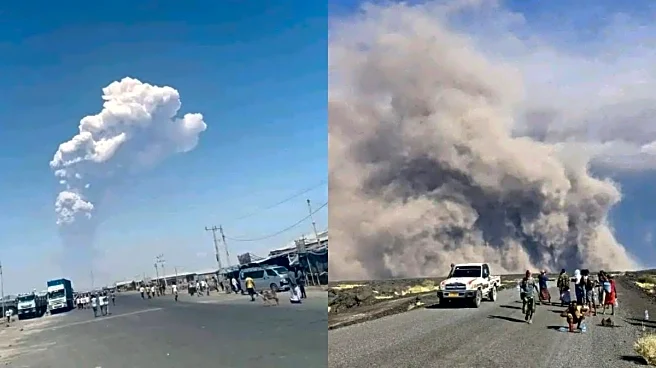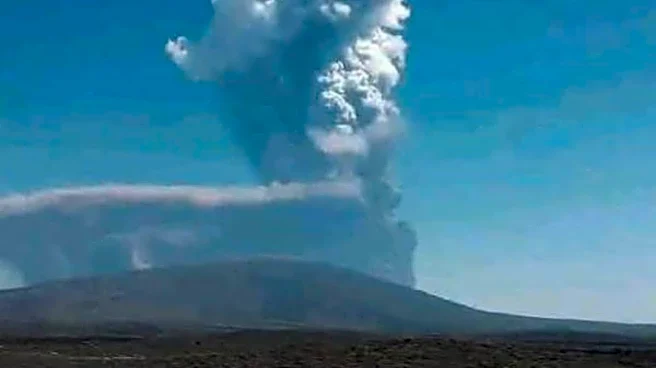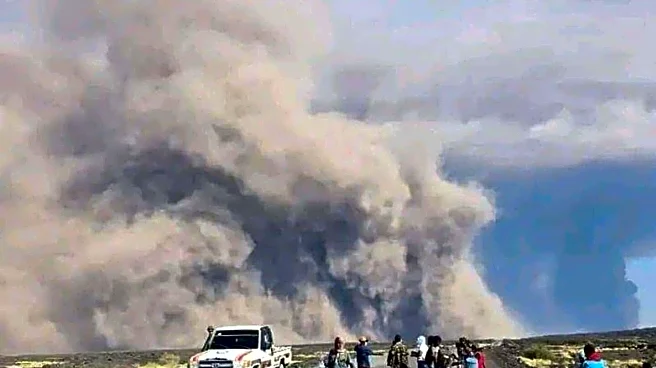A volcano that had slept for nearly 12,000 years suddenly erupted back to life in Ethiopia’s northeast, throwing a towering column of ash almost 14 kilometres into the sky. The Volcano erupted on Sunday
for several hours.
Weather satellites were tracking the ash plume as it drifted across the Horn of Africa. Ash clouds from the volcano drifted over Yemen, Oman, India, and northern Pakistan, the Toulouse Volcanic Ash Advisory Centre (VAAC) said.
The air travel distance between Ethiopia and India is nearly 4,300 km. The Hayli Gubbi volcano is located in Ethiopia’s Afar region, about 800 kilometres (500 miles) northeast of the capital city Addis Ababa, near the Eritrean border.
While the eruption occurred thousands of kilometres away, the DGCA has issued advisories urging airlines in India to strictly steer clear of affected altitudes and regions because, in aviation, distance doesn’t always matter; altitude does.
How Can Ashes From A Volcano In Ethiopia Affect Flights In India?
When such a massive volcanic eruption occurs, the volcano doesn’t just spew smoke. It releases microscopic shards of volcanic glass and rock that can stay suspended for days and travel astonishing distances in the upper atmosphere, the same altitude where commercial jets cruise.
These particles are razor-sharp, heat-resistant, and nearly invisible to pilots. And when a jet engine sucks them in, the ash can melt, coat the engine interior, and solidify into glass, choking the machinery mid-air.
Past incidents have shown how dangerous this can be: planes have lost all engines in seconds after flying through undetected ash clouds. That’s why global aviation agencies treat volcanic ash like an airborne minefield.
Seasonal wind patterns make this eruption even more relevant for India. At 30,000 to 40,000 feet, winds can push ash horizontally across continents, steering it eastward over the Arabian Sea straight toward one of the busiest corridors linking India with the Middle East, Africa, Europe, and beyond.
These are the routes used every day by flights connecting Mumbai, Delhi, Kochi, Hyderabad, and Bengaluru to Dubai, Doha, Abu Dhabi, Istanbul, Nairobi, and European capitals. Even a thin band of ash in these paths can force airlines to make expensive and time-consuming detours.
Planes That Flew Into Ash Clouds
In 1982, British Airways Flight 9, a Boeing 747, flew directly into an ash cloud from Mount Galunggung in Indonesia. All four engines failed temporarily, and the cockpit windshield was damaged, but the pilots managed to restart the engines and land safely.
A few years later, in 1989, KLM Flight 867 encountered a similar fate over Alaska when it entered an ash cloud from Mount Redoubt. Again, all engines flamed out, but the crew successfully regained control and completed an emergency landing.
In 1996, an Aeroflot Tu-154 flying near Kamchatka’s Klyuchevskoy volcano experienced engine surges and instrument damage after entering an ash cloud, yet the plane landed safely.
Volcanic eruptions such as Mount Pinatubo in the Philippines in 1991 and Mount Sakurajima in Japan in 2006 also forced flight cancellations and caused minor aircraft damage.
More recently, the 2010 eruption of Iceland’s Eyjafjallajökull volcano disrupted thousands of flights across Europe for weeks, causing widespread delays but no major accidents.
What If The Volcanic Ash Reaches India’s Skies?
Indian aviation authorities, including the Directorate General of Civil Aviation, are closely monitoring global ash advisories as dispersion models evolve. If ash drifts toward Indian-managed airspace, alerts may be issued, leading to rerouting, altitude changes, or, in extreme cases, flight cancellations.
Airlines may choose longer routes over the southern Arabian Sea, burning more fuel and increasing journey times. A flight that usually takes three hours could take four and a half.
Long-haul flights may need technical stops or reduced payloads. Even domestic schedules could feel the ripple effect as aircraft return late, crews exceed duty hours, and rotations collapse.
There’s also an economic angle: volcanic ash doesn’t need to hit India directly to impact Indian travellers. If major hubs like Dubai or Doha slow down operations because ash has drifted near their skies, flights departing from Indian cities could face long ground delays. Ticket prices may rise, buffers shrink, and airlines quietly tweak schedules to avoid bottlenecks.
How Long Could The Disruption Last?
It is not known yet whether this volcanic eruption was a single explosive burst or the start of a longer eruptive phase. The height of the ash plume, the density of particles, and changes in upper-level winds can all shift within hours.
A sudden intensification could push the ash even higher into jet-stream territory, giving it an express route toward South Asia. Heavy rain in the region might force the ash down quickly, ending the threat just as fast.
For travellers, the impact may manifest as last-minute delays, longer routes, or temporary disruptions on key international sectors. Most passengers will never see the ash cloud responsible for the inconvenience, but airlines, weather scientists, and regulators will continue to track its movement, frame by frame.




/images/ppid_a911dc6a-image-176404544047063153.webp)




/images/ppid_a911dc6a-image-176404286710753090.webp)

/images/ppid_a911dc6a-image-176403763011891870.webp)

